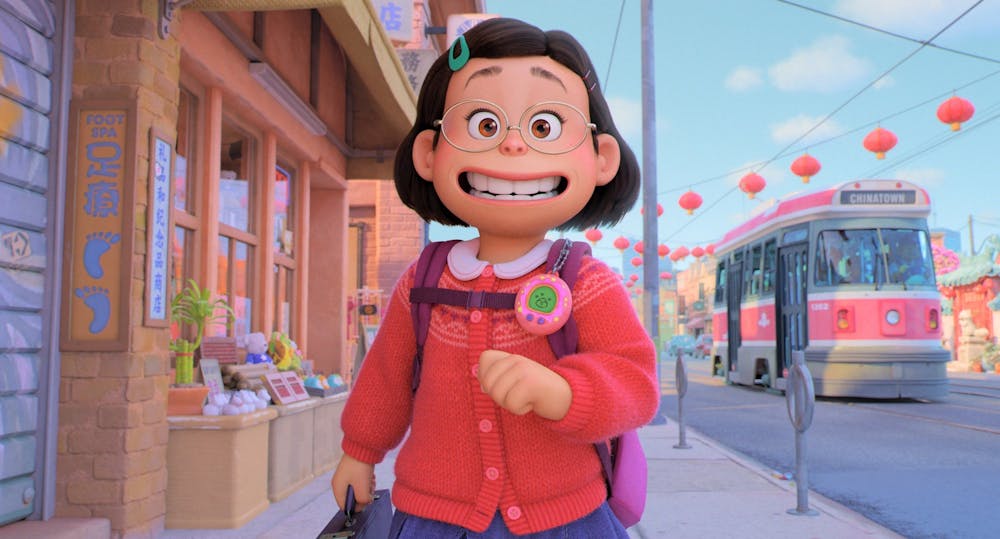Movie: “Turning Red”
Director: Domee Shi
Starring: Rosalie Chiang, Sandra Oh
Studio: Pixar
Rating: 9.5/10
With a Godzilla-esque red panda, the best fictional boy band since Spongebob’s Boys Who Cry and candid discussions surrounding getting a woman’s first period, Pixar’s “Turning Red” presents a surprisingly hilarious and heartfelt story.
Centering around 13-year-old Mei Ling as she navigates her hereditary ability to transform into a giant red panda when experiencing strong emotions, “Turning Red” tells the tale of friendship, family and finding faith in oneself. Set in the year 2002, the film also offers a trip down memory lane with Tamagotchis, vampire romance books and bucket hat-wearing convenience store crushes. It’s simultaneously a nostalgic joyride of easy laughter and a harrowing journey of healing generations-old wounds.
“Turning Red” never fails to stick its landing in comedy that relies on the relatable embarrassment of one’s early teens and the goofiness of middle-school friendships. From Mei’s mother, Ming, bringing her daughter pads in front of her entire class to Mei’s best friend, Miriam, breaking out in song to comfort her friend, “Turning Red” delivers cringe in the best way. The movie offers a time to laugh not only at the script, but at one’s own 13-year-old self, too.
However, “Turning Red” doesn’t merely exist as a lighthearted and fun narrative (which is still very much true). Where “Turning Red” shines is in its treatment of the mother-daughter relationship and how generational trauma develops and how it is healed.
From the start of the movie, the audience is exposed to the intensity of Mei and Ming’s relationship — they are not only mother and daughter, but best friends and co-workers. But despite this closeness, as Mei grows and comes into her own person, the relationship proves overbearing for the protagonist.
There’s little room for Mei to have friends (friends who offer her stability outside of the home) or to have fun (such as going to a 4*Town — a fictitious late 90s/early 2000s band — concert).
Although “Turning Red” pokes fun at this dynamic, it still ingrains the importance of learning from each other, rather than growing against each other.
With this message,“Turning Red” delivers its most effective and heart-wrenching look at healing from generational trauma. The audience learns that Ming’s resistance to Mei accepting her red panda form does not exist without reason — Ming’s own red panda caused pain in her life, a pain that Ming herself is afraid of.
As such, the film humanizes Ming, the mother, by recognizing that she, too, was once a 13-year-old. Ming, who has not healed the wound that divides her and her own mother, also exists as a scared and lost young girl, just like Mei.
Mei’s recognition of her mother as a child who has been mothered allows Mei not only to heal the divide forming between her and Ming, but to accept herself as she comes.
This develops another winning point of “Turning Red” — a reiteration of the message that “one should be themself,” which feels fresh and pertinent.
This message comes through in all the quirks of Mei’s friend group — from the loveable assertiveness of Abby, to the cool demeanor of Priya, to the unabashed loyalty of Miriam. Their conversations sound like that of actual teenage girls — from the uncalled-for crushing over mediocre boys to the verbal spelling out of “O-M-G.”
Each girl acts so similarly and differently from each other, yet accepts one another without question.
Most importantly, they accept Mei as a red panda almost immediately — a stark contrast to the reaction of her family, which seeks to hide and rid Mei of her panda forever.
“Turning Red” is a story of acceptance and the confidence that comes with it.
Overall, the film — Pixar’s first in nine months — neatly balances the pains and awkwardness of adolescence with the hilarity of teenage interests; it candidly embraces its quirks and in doing so, allows for positive change on the individual, familial and community scale.
Kara Anderson is a senior arts editor and can be reached at kara.anderson@ubspectrum.com

Kara Anderson is a senior arts editor at The Spectrum. She is an English and Spanish double major and is pursuing a certificate in creative writing. She enjoys baking chocolate chip cookies, procrastinating with solitaire and binging reality TV on the weekends.





